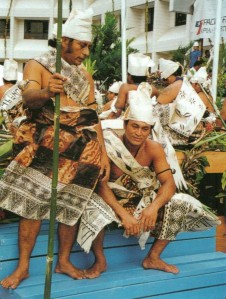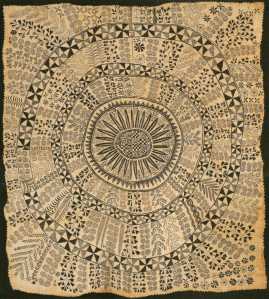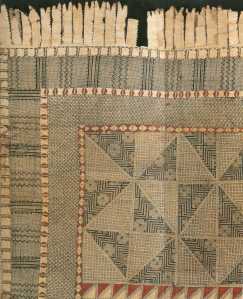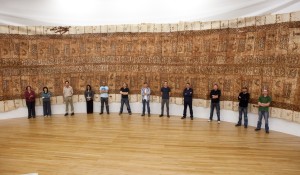kapa kulture
This blog is dedicated to Hawaiian kapa and matters related to Hawai'i nei…kuku kapa e!

Archive for the tag “tapa”
Tapa in Niue
On the island of Niue, hiapo is the term for bark cloth. When Samoan missionaries came to Niue in 1830, it is recorded that they brought hiapo with them, along with the Tahitian tiputa, which is a sort of poncho. It is reasonable to believe that this cultural sharing could be a historical bridge between Samoan and the Society Islands,arising not only from Missionary influence, but also as a result of a long history of inter-island voyaging typical of canoe expeditions in the region.
Although the hiapo is said to have come originally from Samoa, the quality in Niue is different from Samoan siapo. Samples from Niue, are made by felting layers into a single sheet the way it’s done in the Cook Islands. The mystery about hiapo of Niue is that no one knows what it is made for, since the size seems to be small for clothing or blankets. Speculation has it that the very creative designs on Niuen hiapo were made for some sort of commercial purpose. Perhaps the artistry involved points to a creative purpose that served as a pastime activity? Since 1901, no hiapo has been produced in Niue.
The designs on Niuen hiapo are not made with the rubbing method. The Niuens decorated their hiapo with freehand painting that is similar to the Samoan style. Rectangular or circular design compositions with abstract forms and plant forms are drawn with fine black lines, in a grid formation. Occasionally, people, stars, and fish are also drawn into the design. Hiapo beaters found in Niue, called ike, are unique to Niue. The ike are carved with very fine grooves and shaped with a cuff on the handle.
(Neich & Pendergrast, Pacific Tapa, 1997).
Bark Cloth of Uvea (Wallis Island) and Futuna Island
UVEA
In Uvea, the people speak a language closely related to Tonga, the term for bark cloth in the island of Uvea is ngatu. Paper mulberry, hiapo, is cultivated on the east coast where rainfall is heavy. Double layers of ngatu are beaten out and pasted together and are designed using freehand designs or kupesi-imprinted methods. If the kupesi pattern block is used, it is made form the midrib of leaf sewn to wads of leaf as in Tonga, and this is the traditional style for Uvea to make designs on the cloth.
Contemporary kupesi are carved in wood. Freehand painting is also done. The design motifs have changed over time from simple, repetitious patterns to modern designs that show a slice of life such as drinking kava, dancing, climbing trees, and fishing. Uses of ngatu include bed covers and screens, and clothing. There are two types of wrap-around skirts that are distinct in Uvea. One called a lafi that is decorated using the kupesi and then over-painted with black dye. The second is called a tohihina, which is decorated completely with freehand design using a pen in black dye on white ngatu cloth.
FUTUNA
As in Samoa, the general term used for tapa in Futuna is siapo. The name for the paper mulberry plant is lafi. Siapo is the term used when large pieces of the cloth are made by groups of women. A salatasi identifies a smaller sheet made by a single individual that is made into a waist wrap to be worn.
The bottom of an old canoe is carved for use as a design tablet, in the style of Tonga. Designs are also applied using bamboo pens or pens made from coconut midrib. The pens are used to draw very intricate patterned designs. Ruled grids are also drawn to create squared-off areas for a variety of patterns within one piece of cloth. As a finishing touch, sometimes the edges of an article are cut into fringes.
Today, costumes for dance consist of a tepi skirt, a lafi sash worn over one shoulder, and a white turban wrap for the head. Borders on tepi skirts are sometimes created by using freehand painting with a brush and fine lines applied with a pen.

“Dancers from Futuna at the 1996 Festival of Pacific Arts, Apia Western Samoa. The dress of these dancers consists entirely of newly made tapa, from the white turban to the lafe bandolier and the tepi skirt (p.64, Pacific Tapa, R. Neich & M. Pendergrast).
Te Papa Tongarewa Museum in Aotearoa~New Zealand~
Te Papa Tongarewa Museum in Aotearoa, New Zealand has an incredible collection of Pacific tapa on exhibit. The exhibition is on for 2 more days on site. Check out their awesome online tapa gallery by clicking on the link below!
Info about the onsite exhibit here:
Hoʻowehi i ke kapa
Today I am experimenting with various dyes and creating colors that will be used to dye the kapa I have made. I will hoʻawa, extract dye colors from plants, to make ka waihoʻoluʻu, the dye, using ʻōlena for yellow, ʻukiʻuki for blue… overlapped they might make green… we shall see…will post photos later…
The botanical names for these dye plants are:
~ALOHA~
Tapa from Fiji is called Masi
Fijian Masi
The term for the beaten cloth in Fiji is masi. The method for making masi is basically the same as in Tonga where it is prepared using a process of soaking and beating the inner bast of the paper mulberry (Broussonetia papyrifera) is followed by pasting the pounded sheets together for length and strength.
In the past, men commonly wore a malo or masi, which is a strip of plain white bark cloth wound around the waist and between the legs, with a train billowing behind. The longer the length of the train, the greater the chiefly status. For women, everyday clothing was a skirt called a liku. Masi is considered nearly obsolete for traditional dress since its replacement by western style clothing and textiles. Traditional dress styles using masi are not worn as everyday wear but they are still used for dances and important ceremonies like the installation of a chief, or special family occasions.
Ceremonial masi on the occasions of funerals, weddings, and chiefly ceremonies is ongoing. The bride and groom will be wrapped in long pieces of masi, in the customary fashion, and similar coverings would be worn when chiefs are installed. There is great honor associated with masi and it is a symbol of wealth. Gifts of masi are given in extravagance for marriages. It is a source of pride for the whole village to produce this exchange of wealth. Masi is very significant at death and is presented as a gift when someone dies. There is spiritual power associated with masi, as it was “recognized as having ability to carry the strength of the gods” (Fulmer, 1998).
Design work of Fijian Masi
There is a variety of techniques used in Fiji to decorate the masi. They range from freehand painting with pandanus brushes as in Samoa, to Fijian rollers and stencils, to the design tablets of Tongan influence. The finished lengths of masi decorated using rubbing tablets with midrib patterns are known as gatu vakatoga, translated as “Tongan cloth made in the Tongan way.” Gatu vakaviti is a combination of the Tongan rubbing method and the Fijian stencil application method. Gatu vakaviti literally means, “Tongan cloth in the style of Fiji” (Neich & Pendergrast, 1997).
Do you want to know more about Fiji? Here are two good articles that explain current events, traditional foundations, and colonial history:
TRADITIONAL CHIEFS REMAIN CORNERSTONE IN CHANGING FIJI
Fiji’s military ruler disbands Great Council of Chiefs
Dyes & Designs in Samoan Siapo
Faʻa Samoa…In the Samoan Way…
Natural Dye
Dyes used in Samoan siapo come from nature. They are extracted or ground from nuts, tree bark, tree sap, roots, and seeds. There are five colors collected: oʻa is brown, lama is black, ago is yellow, loa is red, and soaʻa is purple. The traditional designs are symbols that reflect Samoan natural environment. There are 13 symbols used in siapo and they represent nets, coconut leaf and sennit, the trochus shell, pandanus blooms, pandanus leaves, breadfruit leaf, sandpiper bird designs, starfish, banana pod, rolled pandanus leaves, worm (this is almost extinct), centipede (which has been discontinued), and lastly, logologo (not found in modern siapo to the point that the meaning of this design has been lost). Original siapo artworks are made by combining these design elements (siapo.com).
Design Methods
There are two kinds of siapo design application methods practiced in Samoa and they are Siapo ʻElei (the rubbing method) and Siapo Mamanu (the freehand method). The Siapo ʻElei method leaves an imprint on the uʻa (bark cloth material). This is done by laying the uʻa on a design printing block that is carved into wood, called an upeti, and rubbing the uʻa with a swab that has been dipped in oʻa. Oʻa is a brown dye that is extracted from the bark of the Bishofia javanica, or blood tree. This is a pest in the Hawaiian Islands where it is known as the Bishop Tree or is called koko (blood). It is also called koko in Tonga and other island languages. The oʻa changes color over time from a pale tan to a rich, dark brown.
The next step in the process is to rub a red color over to define the design. Arrowroot plant is used as glue and is dabbed on any small holes, and then a second layer is placed on top and rubbing the oʻa is repeated, this time pressing the two layers together. Sections are joined using arrowroot and rubbing. This is usually the end of the process for large pieces known as ululima and uluselau. But for smaller pieces called vala, the design might be highlighted with more brown dye. Upeti in the older form was of both the sewn midrib variety as in Tongan kupesi, and also carved wood. Today, the men have been carving the upeti and have become the main artist of siapo ʻelei designs. However, they still base their designs on the traditional symbols. One upeti carving can yield many different imprints as dye can be applied to certain areas only to create an interesting design using the positive and negative space (Pacific Tapa, p. 16, 1997).
Siapo Mamanu is the freehand method of design and is creatively applied by hand using a dried pandanus brush, called a paogo. The design is created by the artist using black dye to sketch the design, and then the artist may choose to use a veriety of color to finish the piece (siapo.com)
These two methods of desing can also be combined to create unique artwork that is reinvented with each piece of uʻa. Siapo is one of the oldest art forms and symbols of Samoan culture. Used for clothing, burial shrouds, bed covers, ceremonial garments, and much more… (siapo.com)
Tapa Designs from the Kupesi of Tonga
Kupesi design tablets in Tonga are constructed by sewing coconut midribs onto a pandanus or coconut leaf sheath. This style of kupesi, which is still used today, is believed to have spread from Tonga to Fiji and Samoa, and beyond to other islands (tongabarkcloth.com).
The designs on Tongan ngatu are known for commemorating historical events in their motifs. Such memorable things in the life of Tongans as the introduction of bicycles, electric poles, and other historical events have been recorded in ngatu designs to document these occasions. Abstract and natural motifs are used. Ngatu ʻuli is black and used only for funerals, whereas ngatu tahina was lighter and used commonly.
Although ngatu is not worn as clothing anymore it is still highly valued. It continues to be a very important traditional koloa (treasure of women) and given as a gift item at ceremonies such as births, weddings, and funerals. It is given in amounts that make a statement about rank and social standing. This is an important facet of Tongan culture and has been recognized by scholars as part of the Tongan cultural system of gift exchange in a ceremonial economy.
Tongan Tapa: Ngatu
Ngatu is the name for tapa in the kingdom of Tonga. As is common among other bark cloth throughout Oceania, it is made from the paper mulberry or hiapo, the Hibiscus, or the breadfruit tree.
Ngatu is still manufactured in Tonga today in large amounts. Women work together in groups to pound out large sheets using a long log as the anvil on which to beat the fibers of the tree bark. This wooden anvil is called a tutua. The beater used to pound the inner bark fiber is called an ʻike. Small pieces, called fetaʻaki, are joined together to make the full sized ngatu. Joining the sheets is done simultaneously while applying the design. Kupesi are placed underneath the fetaʻaki. Kupesi are the design tablets that transfer a design motif to the ngatu. First the kupesi is rubbed with brown pigment from bark of the koka tree (Bischofia javanica). Arrowroot is used as paste to attach the fetaʻaki together. The next stage in the process after the first rubbing with brown dye is to rub the entire surface again putting a new layer of dye. This makes the patterned design of the kupesi emerge like rubbing on a coin. The rubbed layer can also be over-painted with darker colors for more definition in the design.
Eventually, the cloth will become stiff and water repellant from the process of joining, pasting, and rubbing, which continues until the piece becomes as large as needed. Usually ngatu can be made 50 to 100 feet long or even longer. Some pieces have been known to be one mile long (!) and are carried and presented by long lines of women who support it on either side.
Website Blog: Museum of New Zealand – Te Papa Tongarewa
Hawaiian Word of the Day: ʻumeke
ʻumeke: Bowl, calabash, circular vessel, as of wood or gourd. ʻUmeke kāʻeo, a well-filled calabash [a well-filled mind]. ʻUmeke pala ʻole, calabash without a dab [empty bowl, empty mind]. hoʻo.ʻumeke, hōʻumeke. To assume the shape of a bowl; to assume the shape of fruit, to bear fruit. Fig., to have enough to eat. E pua ana ka ʻōhiʻa ʻai a hōʻumeke i ka malama o Hinaiaʻeleʻele, the mountain apple blooms and fruits form in the month of Hinaiaʻeleʻele.
ʻumeke ʻai: Poi bowl. Fig., source of food, of the uplands.
ʻumeke ipu kai: Bowl, as for serving meat or salty meat.
ʻumeke kepekepe: Bowl with horizontal flat panels. Lit., wedged bowl.
ʻumeke lāʻau: Wooden bowl.
ʻumeke mānaʻai: Very small bowl, as formerly used for poi by favorite children. Lit., poi mouth-fed bowl.
ʻumeke ʻōpaka: Bowl with vertical panels with vertical edges between them.
ʻumeke palapaʻa: Thick-bottomed wooden calabash. Lit., firm-dabbed bowl, perhaps so called because dabs of poi are held firm in this type of calabash that does not upset.
ʻumeke pāwehe: A decorated gourd bowl, as made on Niʻihau.
ʻumeke pōhue: Gourd calabash.
Photo found on the Kaʻahele Hawaiʻi Website. Click below to access more information on Hawaiian ipu and more resources for Hawaiian culture and arts.
-
Recent Posts
Archives
Categories
Meta

















